

Barbarian. Keats-Shelley Memorial House. Coordinates:
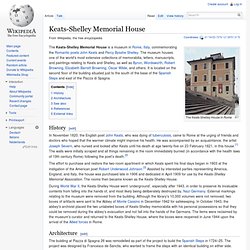
Secrets of Lost Empires. Welcome to the companion Web site to the NOVA program "Roman Bath," scheduled for rebroadcast on January 31, 2006.

In the film, which is a part of the NOVA series Secrets of Lost Empires, an international crew of archeologists, engineers, and historians designs, builds, and tests a functioning Roman bath in the Turkish countryside. Here's what you'll find online: A Day at the Baths Wander through the frigidarium, tepidarium, caldarium, and other vital rooms in our online reconstruction of the famous Baths of Caracalla.
Construct an Aqueduct (Hot Science) The Emperor has appointed you Chief Water Engineer on an aqueduct-building project. To successfully ferry water from the hills, you'll need to learn when to use a tunnel or a covered trench, a wall, or an arcade. Good luck! A Day at the Baths | Construct an Aqueduct | Watering Ancient Rome NOVA Builds a Bath | Real Roman Recipes | Resources | Transcript © | created January 2000. Borghese + Barberini + Corsini + Spada Gallery - Official Site. Spanish Steps. The Spanish Steps (Italian: Scalinata della Trinità dei Monti) are a set of steps in Rome, Italy, climbing a steep slope between the Piazza di Spagna at the base and Piazza Trinità dei Monti, dominated by the Trinità dei Monti church at the top.
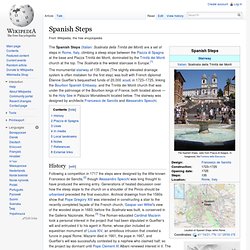
The Scalinata is the widest staircase in Europe.[1] History[edit] Following a competition in 1717 the steps were designed by the little-known Francesco de Sanctis,[2] though Alessandro Specchi was long thought to have produced the winning entry. Roma 2000. Quotes, Poems, Novels, Classics and hundreds more. Nova Roma. Art History Resources for Students, Enthusiasts, Artists and Educators ... Musei Capitolini. Pliny the Elder. For my part I deem those blessed to whom, by favour of the gods, it has been granted either to do what is worth writing of, or to write what is worth reading; above measure blessed those on whom both gifts have been conferred.
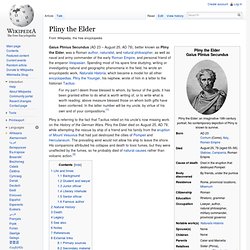
De Imperatoribus Romanis Roman History. Rome. Rome (/ˈroʊm/; Italian: Roma pronounced [ˈroːma] ( ); Latin: Rōma) is a city and special comune (named "Roma Capitale") in Italy.
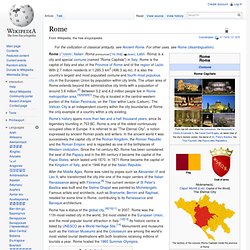
Rome is the capital of Italy and also of the Province of Rome and of the region of Lazio. With 2.7 million residents in 1,285.3 km2 (496.3 sq mi), it is also the country's largest and most populated comune and fourth-most populous city in the European Union by population within city limits. All Empires: Online History Community. Musei Vaticani - vatican museum. Livius. Articles on Ancient History.
Vatican Museums. Trevi Fountain. History before 1629[edit] Trevi Fountain in Rome, Italy Legends[edit] Legend holds that in 19 BC thirsty Roman soldiers were guided by a young girl to a source of pure water thirteen kilometers from the city of Rome.
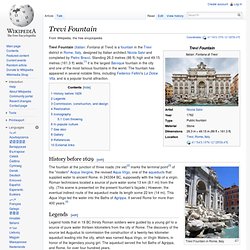
List of tourist attractions in Rome. The Colosseum, Rome's second and the world's 39th most popular tourist attraction, with 4 million tourists a year.[1] List[edit] Religious edifices[edit]
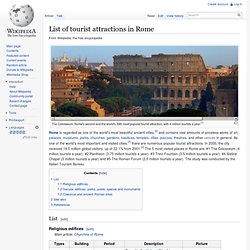
Roman cuisine. Roman cuisine is the cuisine of the Italian city of Rome.
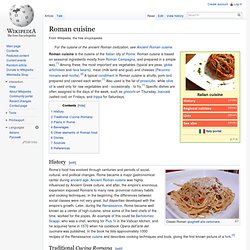
Roman cuisine is based on seasonal ingredients mostly from Roman Campagna, and prepared in a simple way.[1] Among these, the most important are vegetables (typical are peas, globe artichokes and fava beans), meat (milk lamb and goat) and cheeses (Pecorino romano and ricotta).[2] A typical condiment in Roman cuisine is strutto, pork lard prepared and canned each winter.[1] Also used is the fat of prosciutto, while olive oil is used only for raw vegetables and - occasionally - to fry.[1] Specific dishes are often assigned to the days of the week, such as gnocchi on Thursday, baccalà (salted cod) on Fridays, and trippa for Saturdays.
History[edit] Rome's food has evolved through centuries and periods of social, cultural, and political changes. Rome became a major gastronomical center during ancient age. Traditional Cucina Romana[edit] Oath of the Horatii. Oath of the Horatii (French: Le Serment des Horaces), is a large painting by the French artist Jacques-Louis David painted in 1784 and now on display in the Louvre in Paris.
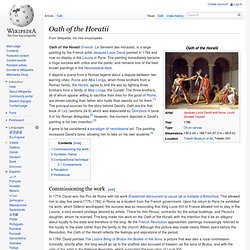
The painting immediately became a huge success with critics and the public, and remains one of the best known paintings in the Neoclassical style. It depicts a scene from a Roman legend about a dispute between two warring cities; Rome and Alba Longa, when three brothers from a Roman family, the Horatii, agree to end the war by fighting three brothers from a family of Alba Longa, the Curiatii. The three brothers, all of whom appear willing to sacrifice their lives for the good of Rome, are shown saluting their father who holds their swords out for them.[1] The principal sources for the story behind David's Oath are the first book of Livy (sections 24-6) which was elaborated by Dionysius in book 3 of his Roman Antiquities.[2] However, the moment depicted in David's painting is his own invention.[3] Symbolic theme[edit]